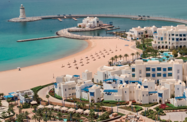With a strong existing market from business visitors, and a growing status among tourists from elsewhere in the Gulf, Qatar’s authorities are now focusing on developing a broader leisure industry.
The tourism and travel sector contributes QAR12.4bn ($3.4bn) to GDP directly, equivalent to 1.8% of economic activity, according to the World Tourism and Travel Council (WTTC). But the industry’s total contribution – direct, indirect and induced, including its boosting effect on other sectors – is almost four times as big, at QAR47.6bn ($13bn), or 6.7% of GDP. The WTTC expects sector growth of 7.1% this year, and an annual average of 4% from 2013 to 2023. For its broader impact on the economy, these figures rise to 8.1% and 4.5%, respectively.
On June 1, Saeed Al Hajri, chairman of the tourism committee of the Qatar Chamber of Commerce and Industry, announced that the state was stepping up its efforts to reach 20% annual growth in arrivals numbers, with a particular focus on visitors from other GCC member states. He said that tourism development goes hand-in-hand with broader economic growth, each supporting the other.
Al Hajri emphasised Qatar’s status as a “luxury destination” and a focus on “quality over quantity”, implying a continued concentration on the top end of the market – which particularly appeals to citizens of Qatar’s wealthy Gulf neighbours, including populous (and less liberal) Saudi Arabia, as well as well-heeled visitors from elsewhere in the world. Al Hajri said that new luxury hotel brands setting up in the country would further strengthen the appeal to visitors from the Gulf.
He added that Qatar Airways, the state-owned flag-carrier, was playing a central role in bringing more visitors. The airline has grown as a global force in recent years, and now flies to around 125 destinations worldwide. It offers a number of packages to tourists visiting the State, including to stopover passengers travelling on its many transit routes.
Qatar’s adoption of a Tourism Satellite Account (TSA) by the end of next year should further strengthen its ability to develop the sector. The TSA is an UN-approved system for monitoring and measuring tourism’s impact on the economy. Enhanced data collection and analysis should not only enable better policy planning, but also help structure development to improve sustainability and the industry’s environmental impact.
Along with strategic planning and brand development has come significant capital expenditure, with the state planning to invest $20bn in tourism infrastructure between 2011 and 2022 in preparation for the World Cup. This will include building an average of 5000 new hotel rooms a year, boosting the number from 15,000 to 60,000. The aim is to attract as many of the world’s top brands as possible.
Aware of the potential for oversupply, the Qatar Tourism Authority (QTA) sees the World Cup as a landmark, but not the only event towards which the sector should be geared. The expectation is that the infrastructure and profile boost associated with the World Cup will help enhance Qatar’s position as a host for sporting tournaments and events over the long term, ensuring a steady traffic of visitors. The meetings, incentives, conferences and exhibitions (MICE) segment is one potential target. This is an area where Qatar has already had some success, accounting for 72% of visitors in 2011.
As the new Hamad International Airport (formerly known as New Doha International Airport) ramps up to its 50m capacity, the QTA also expects the volume of transit passengers stopping over to increase. The first phase of the project is expected to be completed by the end of 2013, with the facility fully operational by 2020.
Qatar certainly does not intend to become a mass-market tourism destination; nor would this be realistic given its size. But by shrewdly focusing on segments such as business, luxury leisure, sport and short stays by transit travellers, it could increase the sector’s contribution to the economy, and support diversification.

